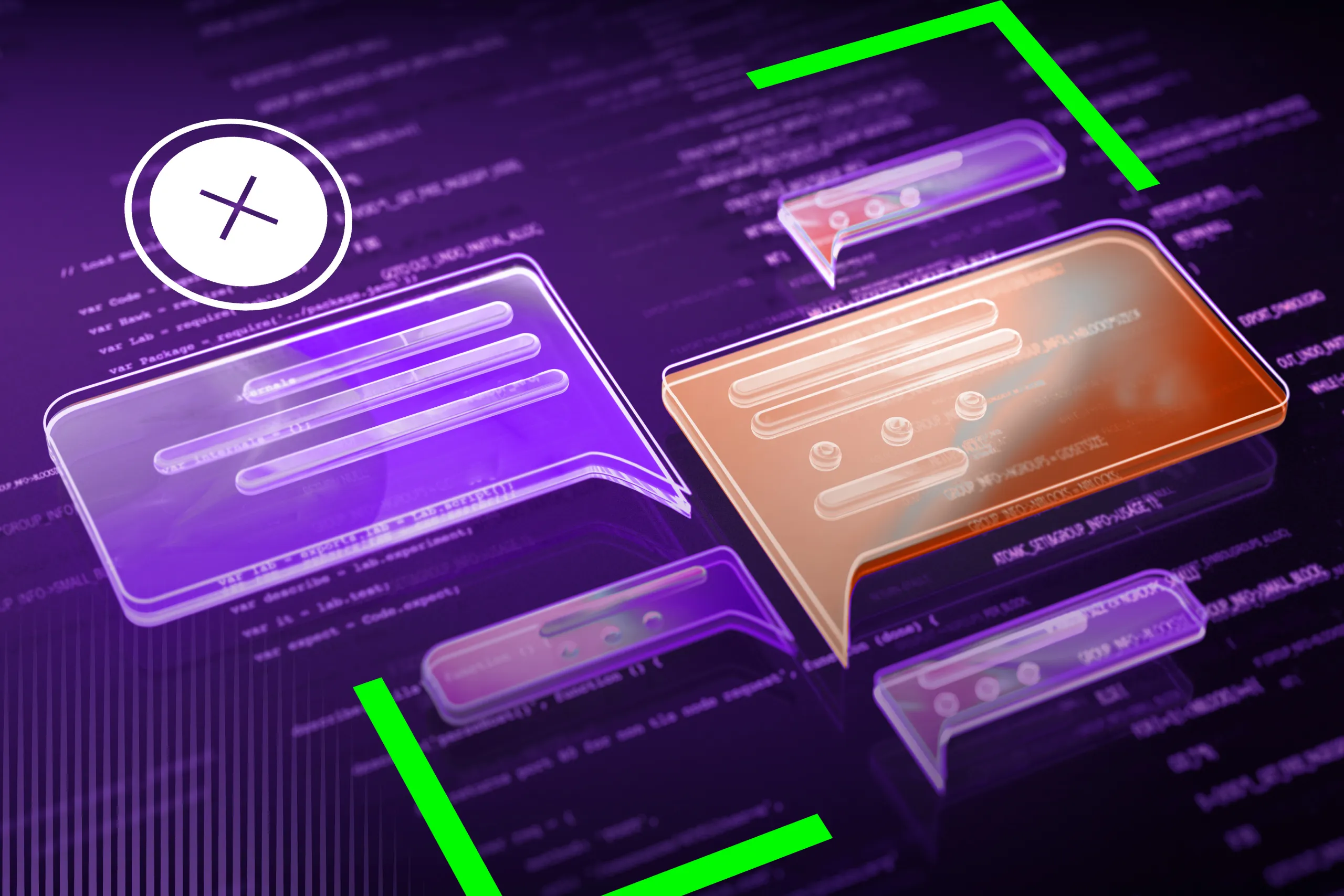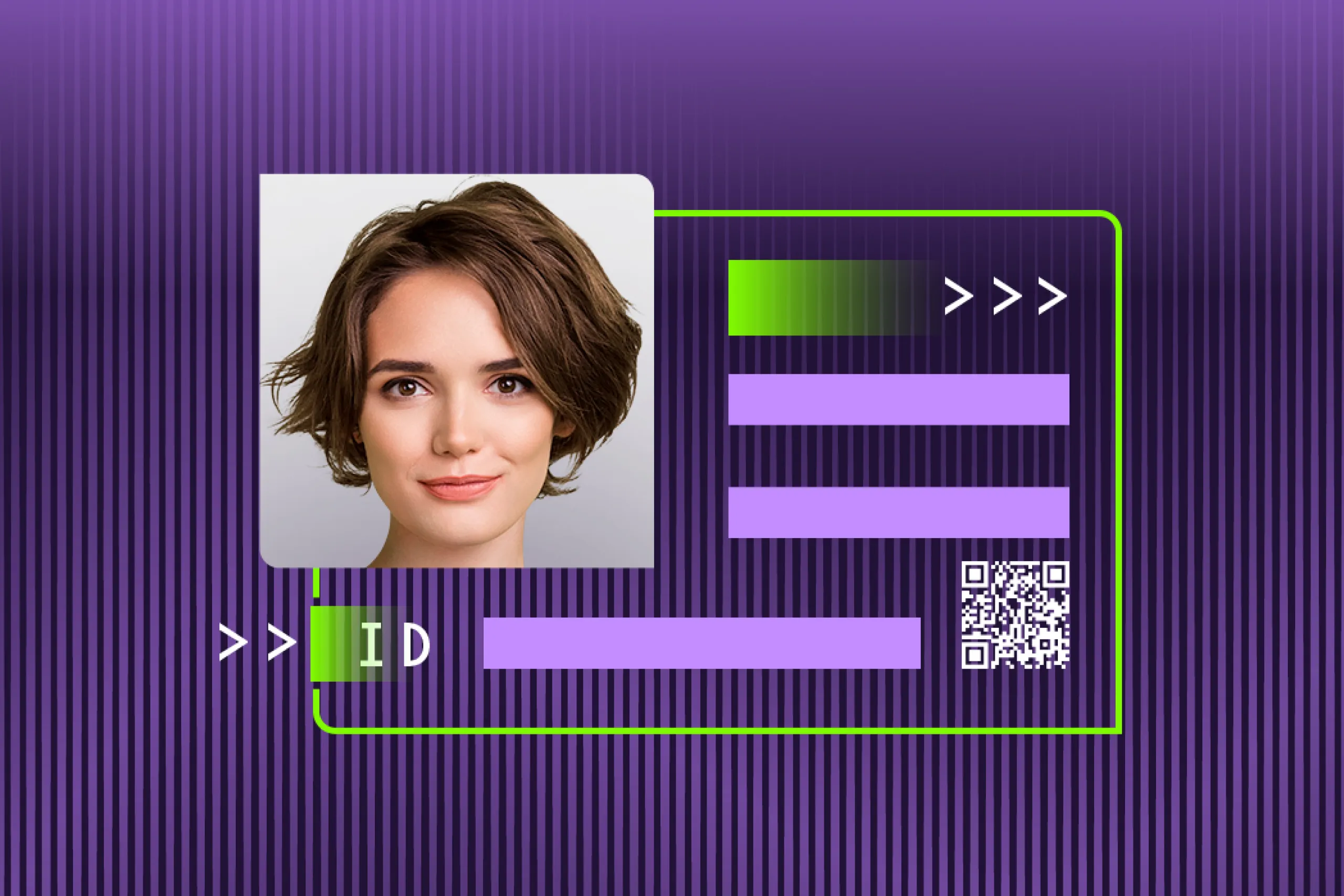Visa verification typically occurs during passport checks at border crossings, but sometimes, a visa can function as a standalone identity document. Moreover, many companies now have to verify visas remotely.
In this article, we’ll focus on the key aspects of visa verification, highlighting the challenging parts and presenting tools that can help businesses successfully complete the task.
💡Curious about other ID documents and what makes them unique?
Read our expert reviews of:
The anatomy of a visa: Data and security features
A visa is an official document often issued by a state’s representative agencies serving in foreign countries. Technically, it is a paper sticker that is affixed to a passport or other travel document. It entitles the holder to cross the border and stay in the country or territory for work, study, tourism, and other purposes during a particular period of time.
Countries began using visas as regular travel documents in the early 20th century. Initially, they often appeared as stamps, marks, or government-issued letters granting the bearer official permission to enter different territories. After World War II, visas (as well as passports) became more standardized through bilateral agreements between nations.
According to the ICAO’s Doc 9303 (part 7), all visas should be machine-readable and meet specific requirements regarding layout and data. However, these are recommendations, not strict requirements. In real life, visas are less unified than other travel documents, such as passports, which makes verifying them a challenge.
The ICAO’s recommendations define mandatory data and features. A machine-readable zone (MRZ) is one of them. Yet, some countries omit this component in their visas, issuing non-machine-readable visas that cannot be considered ICAO-compliant.

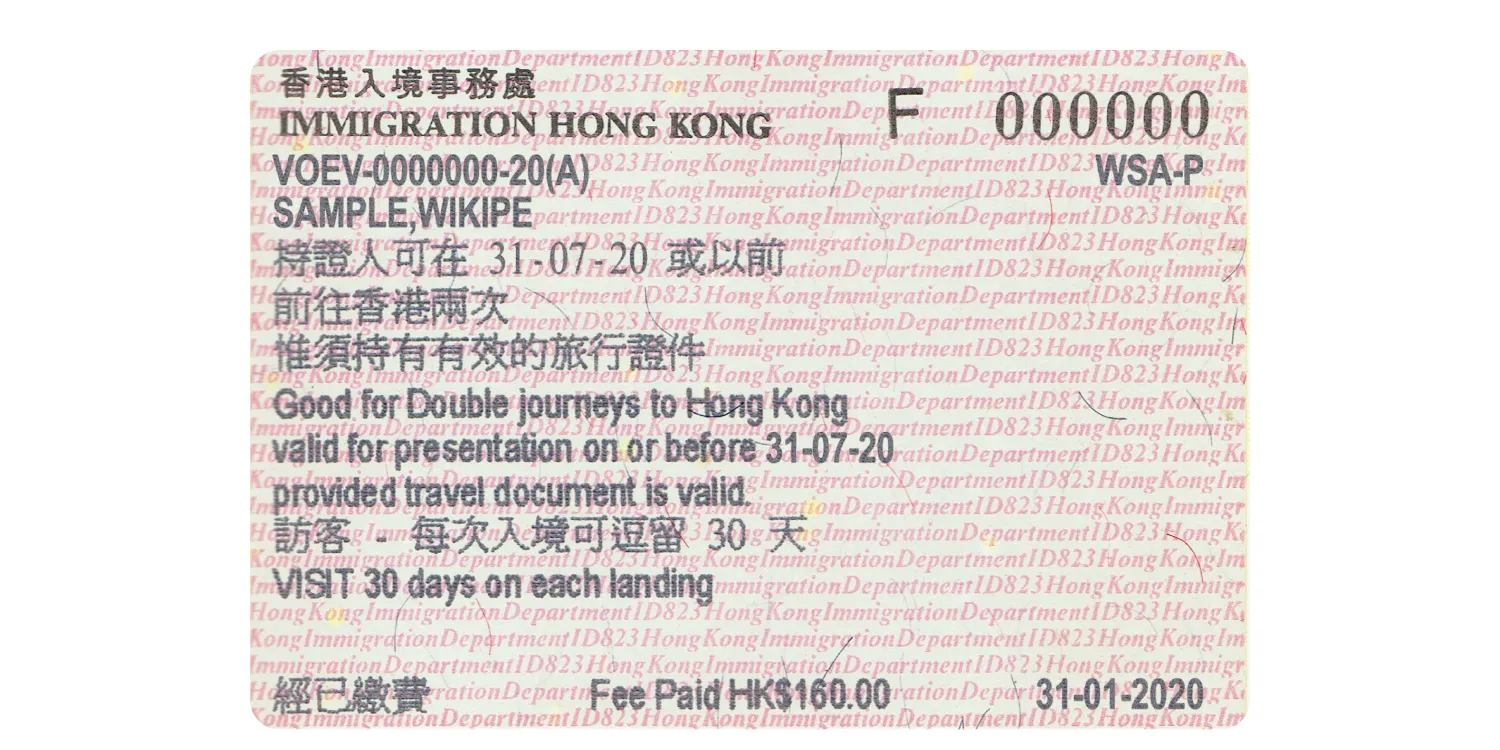
Both Laos (above) and Hong Kong (below) issue visas without an MRZ. Additionally, in the Hong Kong visa, a specific layout is used, which is non-compliant with the ICAO recommendations. Source: Wikipedia.
These details about the bearer and their travel are stated as mandatory for visas by the ICAO:
- Name
Issuing state
Visa validity data
Type of visa
Place of issue
Number of entries
Visa number, etc.

Visas issued under the Schengen agreement are the most unified in terms of design and layout; in particular, there is always an EU flag at the top left. For instance, this is what a Swiss visa from 2019 looks like.
Personal details like the holder’s passport number, sex, date of birth, and nationality can be added optionally.
Surprisingly, the holder’s portrait also isn’t a must. There are many visas where a photo is inserted with a national symbol or logo as a mandatory identification feature.
The list of common choices of security features in visas includes:
UV features revealing intricate patterns under ultraviolet light
Security fibers
Infrared (IR) inks
and more.

When exposed to UV light sources, many visas show beautiful patterns. For instance, there is a complex UV feature in a Switzerland visa from 2019.

Some states use IR inks in their visas that can be observed in IR light of 850-950 nm. In a 2019 series Swiss visa, the travel and personal data as well as the holder’s portrait stay visible under IR light sources.
When and how visas are verified
The first situation that comes to mind for visa verification is border crossing. Border officers check the document's authenticity and validity for all cases, including first entry, return home, and transit.
Other use cases associated with visa verification may involve regular employees. The visa may be checked when its holder:
Сhecks in prior to the flight: If a passenger crosses the border by air, their visa can be reviewed at the airline checkpoint before departure. This ensures that the passenger will be allowed to enter the destination country.
Onboards as a new employee abroad: Employers hiring non-residents check the validity of their work visas to complete the onboarding of new international employees.
Opens a bank account as a non-resident: A visa is submitted during the onboarding stage, enabling workers, digital nomads, students, and other temporary residents to become regular customers of banks or financial services companies.
Arrives at a university’s campus as an international student: Educational institutions enrolling foreign students must comply with immigration regulations. For instance, international students at Harvard must present their visa, among other documents, when completing an online form to complete the required immigrant registration process.
Rents an accommodation for an extended period abroad: Landlords can verify that a tenant who is not a permanent resident has a valid visa and proof of employment before entering into an agreement.
The use cases mentioned above involve using different tools and methods during visa verification.
For in-person checks, hardware solutions are available, such as ID document readers with UV and IR light sources. These devices usually automate data extraction and data entry, as well as provide tools for manual and automated examination of security features. Importantly, using hardware tools requires specific skills and experience in visa verification. That’s why these solutions are primarily used at countries’ borders.
For online checks, software solutions such as Regula Document Reader SDK come in handy. They perform a wide range of authentication checks, including MRZ reading, data recognition in the visual inspection zone, liveness detection, and lexical analysis, while flagging any irregularities. Typically, visa verification software is integrated into the web platform or app, making the application process fully automated, fast, and smooth for customers.
Whatever flow the individual organization prefers, there are some tricky parts that need to be considered.
Get posts like this in your inbox with the bi-weekly Regula Blog Digest!
Why is visa verification so complicated?
When verifying visas, companies may face the following challenges:
1. Non-standard layouts and designs of visas
Except for documents issued by Schengen Agreement members, visas from different countries vary significantly. These differences include size, layout, design, and language, which may be non-Latin (Arabic, Chinese, etc.).



The ICAO’s requirements allow states to use several layouts where a variety of identification and security features can be mixed. As a result, some countries like Australia and Thailand place their crests on visas, instead of the holder’s photo, as Japan does.
What’s more, a visa is a paper sticker that is manually pasted into the travel document. The information in the data fields and verified stamps is often printed on an empty secure blank. Since there is no lamination, “legal” irregularities, such as ink traces, abrasions, and letter shifts, can be detected in the document.
As a result, to verify visas correctly, it’s crucial to have an experienced inspector or robust software solution. On the one hand, the majority of visas checked by border officers or regular employees are issued by the countries they belong to. Mutual visa recognition agreements, such as the Schengen Agreement, aim to simplify the process for states managing active tourism and work migration flows. However, on the other hand, visas from different countries remain too distinct and dissimilar.
While an inspector can rely on their own expertise, a software solution requires a large visa template database in the background to check various visas correctly. For instance, Regula now possesses over 500 visa templates, and the library is continually updated.
Information Reference Systems (IRS) for manual visa examination
A database of visa references can assist experts as well, because they may encounter a document they have never seen before. For such cases, Regula provides IRSs containing images and detailed descriptions of visas and other identification documents along with their security features at several protection levels.
2. A variety of machine-readable features
Visas may contain components that can be verified only with specific tools or software, such as MRZ codes and barcodes.
The ICAO provides construction and encoding rules for such features; however, countries have some freedom when implementing them in visas.
Visa issuing bodies employ various types of barcodes since the regulations define them as optional components. In practice, there are linear and 2D barcodes like PDF417, Data Matrix, and Visible Digital Seals, which include different data groups and are recognized using specific algorithms.

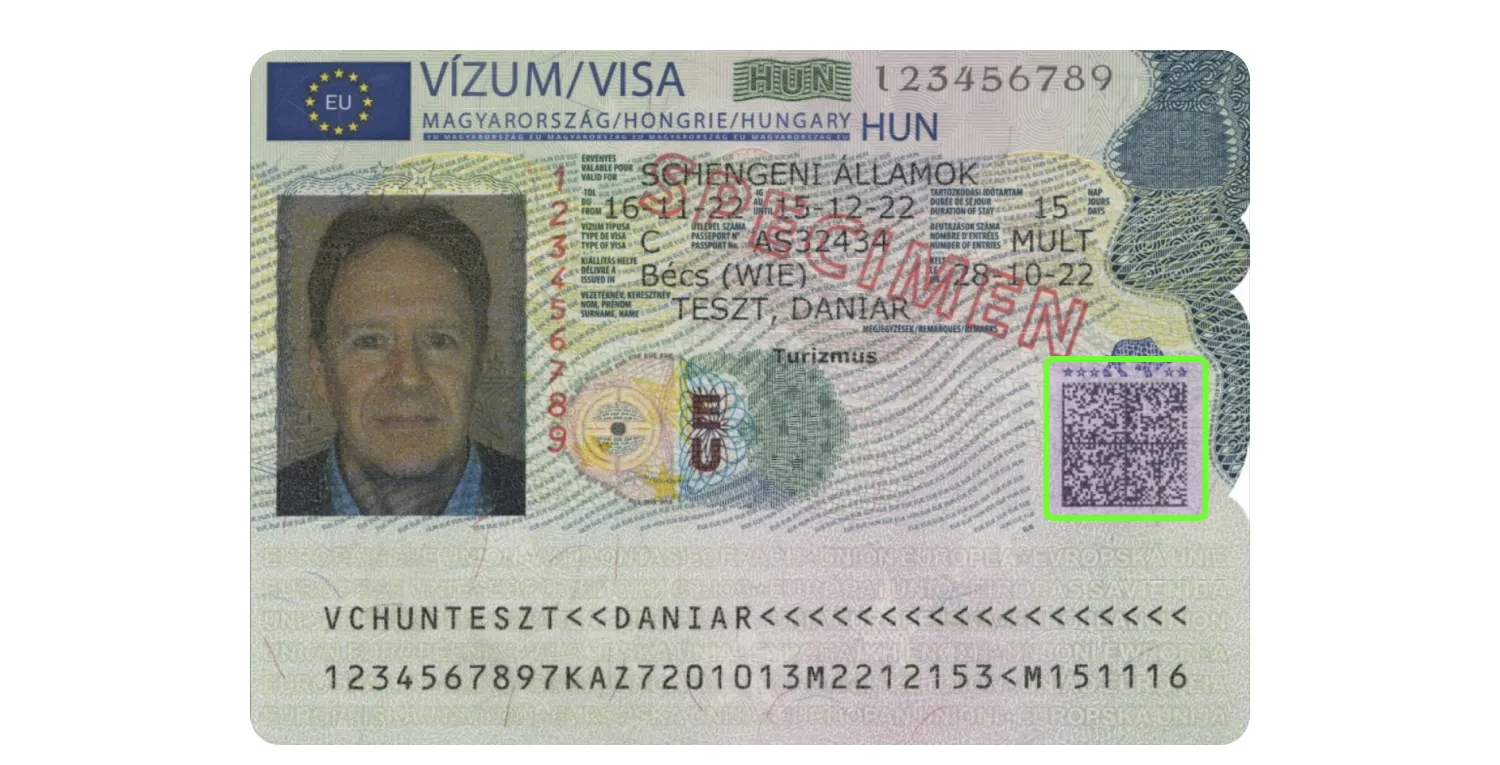

There are different types of barcodes used in visas: a QR code like in a Philippine visa, Visible Digital Seals like in a Hungarian visa, and PDF417 like in a Mozambican visa.
In the MRZ, non-standard cases occur as well. From unusual font styles to lines of uneven length, MRZ recognition in visas can be challenging.


While some countries, such as the US, follow the recommendations using a particular font style and size in the MRZ zone, others, such as Qatar, make their own choices. Non-standard MRZ codes can be successfully verified only with IDV solutions designed for this type of irregularity.
A solution that is used for such tasks must consider all these specifics. Otherwise, errors and false positives or negatives are possible.
3. Electronic visas
Some countries ditch paper stickers when it comes to visas. For example, Saudi Arabia and the UAE have legitimate electronic visas for travelers from particular states.
An e-visa is a PDF document containing standard data on the holder: a photo, name, travel details, etc.
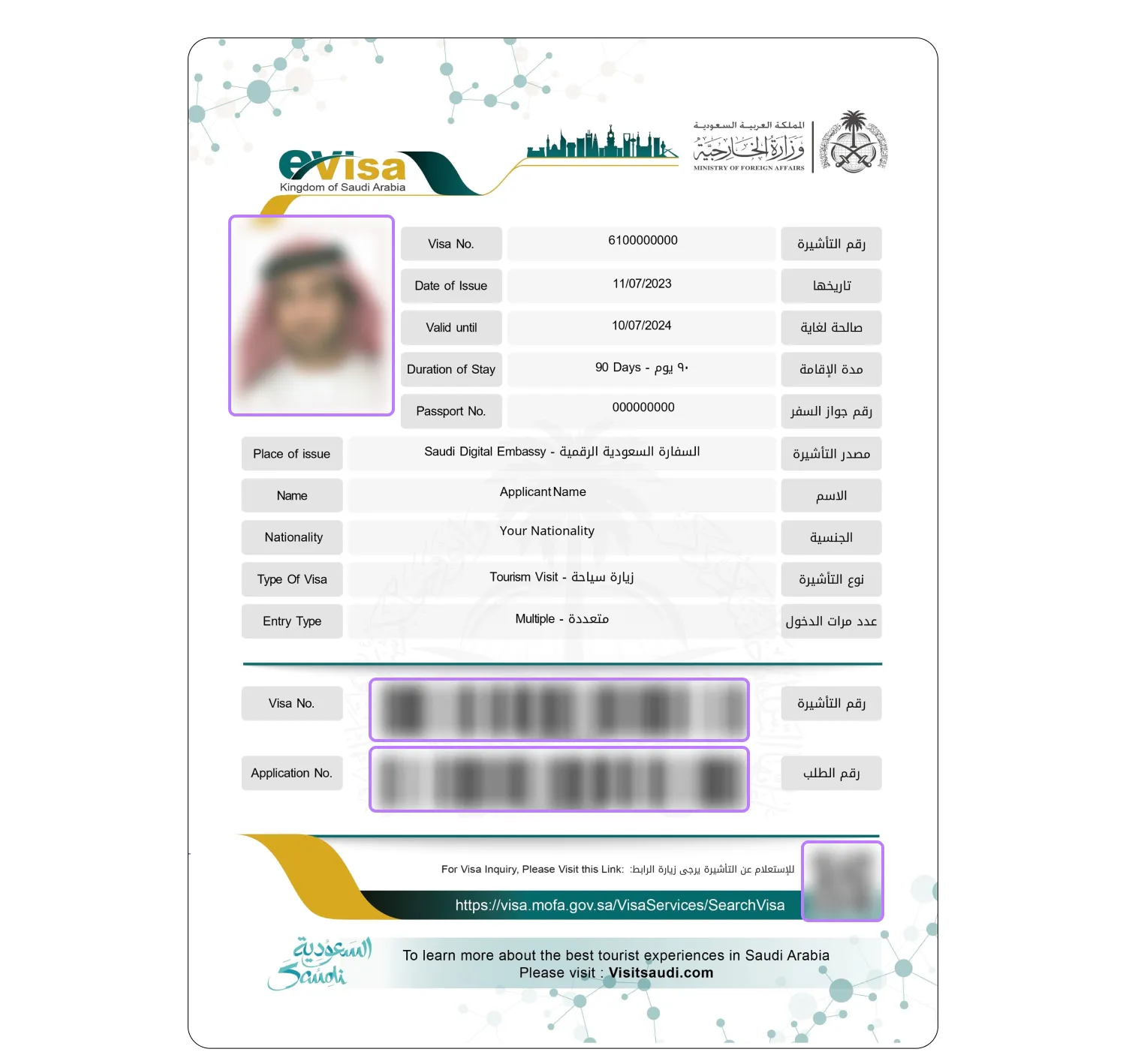
A Saudi e-visa looks like an A4 PDF. E-visas are typically sent to applicants via email after approval and should be printed before crossing the border. Source: www.saudi-arabia-evisa.com.
Additionally, there are unique identifiers, such as a visa number and an application number, that make it possible to verify an e-visa. During verification, the identifiers are matched against a database of authorized visitors. This process can be automated with identity verification software.
4. Increased forgery threat
For some groups of people, such as illegal migrants, a visa is often a “one-way ticket” to a better life. However, immigration policies in prosperous countries where many people would like to settle down are now becoming more strict. As a result, there is a stable demand for visas in the counterfeit identity document market.
As a paper sticker or PDF document, a visa is easier to counterfeit or fraudulently modify than other IDs. When pasted in a legitimate passport presented by its real holder, it looks more compelling, and slightly blunts the inspector’s vigilance.
For this reason, companies have to deal with forged or counterfeit visas more often than other identification documents. This means reliable hardware and software solutions are needed to detect fraudulent traces and inconsistencies, especially when the visa verification procedure involves non-experts.
What will visas look like in the future?
Considering all the disadvantages of paper visas, states continue looking for more secure solutions allowing them to avoid physical documents. Many developments in this field imply local agreements and traveler data exchange.
For instance, in the EU, the Entry/Exit System (EES) enters into operation in early November this year. Under the EES, non-EU nationals are required to scan their passports when entering the Schengen free-travel area. All entry and exit data, including the visitor’s name, type of travel document, fingerprints, and facial images, will be recorded in the European Travel Information and Authorisation System (ETIAS).
In addition to replacing manual stamps, the automated system provides a more robust mechanism for border control since all security incidents—entry refusals, overstays, and attempts to enter the EU on forged documents—will also be captured.
In the future, visas as physical documents can also be replaced with digital assets, including secured barcodes. For instance, in 2021, the ICAO introduced non-physical Digital Travel Authorizations (DTA) for use by all 193 ICAO member states. This system allows for remote travel authorization by submitting identification data, including an ID and biometrics, to officials. If approved, a 2D barcode is issued, confirming that the traveler is permitted to enter the country under specific conditions. The barcode contains all the necessary information about the traveler and their journey, and can be verified by border officers, airlines, and other entities. The entire process, from applying for a DTA to receiving entry permission, is conducted digitally, saving time and money for both travelers and authorities while enhancing security.
Since fraudsters never cease their attempts to bypass security measures, all these changes will require new technologies and verification solutions. In particular, no e-visa program is complete without data entry, processing, and verification for all applicants.
The majority of visas are still stickers in passports. Regula can assist you with both on-site and online visa checks, while also providing robust solutions for the more advanced visa systems of the future.




